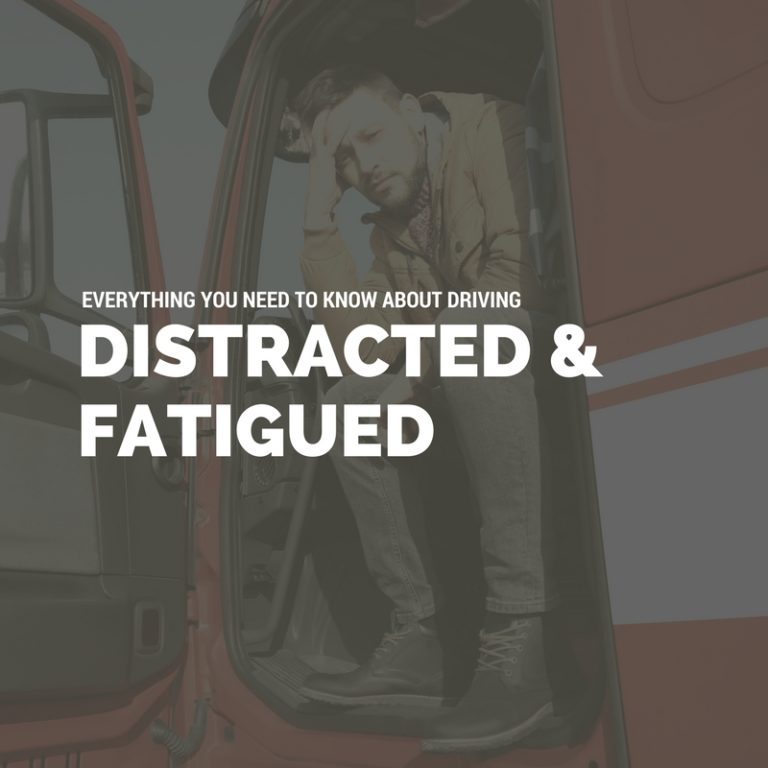
Everything You Need to Know About Driving Distracted & Fatigued
As drivers, you know how important your job is. With the vast majority of the nation’s freight tonnage moved by trucks, the economy would come to a standstill without each and every one of you. Therefore, you want to always put your best foot forward on the job. This means not only working hard and being productive, but also staying safe and alert on the road.
Getting behind the wheel of a vehicle is a significant responsibility – but trying to maneuver a large, 18-wheel, commercial truck? Well, that’s another story entirely. Over a span of nearly three years, over 12,000 commercial truck accidents were reported, and around 4,000 crashes end in fatalities each year. Two of the leading causes of these accidents are distracted and fatigued drivers.
Don’t Drive Distracted
A recent study found that the most distracted drivers are 36% more likely to be involved in a collision. The FMCSA defines distracted driving as “the diversion of attention from activities critical for safe driving to a competing activity.” Distractions can come from both the inside and outside of your truck cab, and include:
- Texting
- Making calls
- Reading
- Eating
- Outside distractions (billboards, buildings, people, etc.)
Texting while driving is illegal for commercial truck drivers, and the FMCSA has a set of rules for limiting the use of mobile devices while driving. The FMCSA defines texting while driving as “manually entering alphanumeric text into, or reading text from, an electronic device.” Yes, you read that right – this includes reading a text message. If you are caught texting or using your device for other prohibited purposes while driving, there are sanctions such as fines up to $2,750 and driver disqualifications.
Here’s what you can do, though:
- Locate the mobile phone so it is operable by the driver while restrained by properly
adjusted safety belts. - Utilize an earpiece or the speakerphone function.
- Use voice-activated or one-button touch features to initiate, answer, or terminate a call.
Don’t Drive Fatigued
Driver fatigue has been an issue that drivers have dealt with since long before the invention of mobile phones. The trucking industry is notorious for being full of overworked and exhausted drivers. It is easy for drivers to neglect sleep due to deadlines and pressure from carriers, and their drive for being great at their job can get in the way of rest time. When this happens, drivers are at risk of falling asleep behind the wheel or experiencing fatigue that results in accidents.
This was a large reason for the FMCSA’s introduction of the ELD mandate. The mandate is designed to create a safer work environment for drivers by ensuring that they are not exceeding Hours of Service (HOS) rules. Because of this new requirement, drivers will be able to get more rest, therefore cutting down on driver fatigue. It also helps cut down on driver harassment from carriers, as drivers can no longer be forced to work more hours than they should be.
ELDs like the My20 ELD App are designed to alert drivers when they need to take a break and rest. To read more about this feature, as well as the other features My20 offers, check out this page.
Other Causes of Roadway Accidents
In addition to distracted and fatigued drivers, we wanted to mention a few other causes of
accidents on the road that directly affect drivers:
- Traveling too fast for conditions
- Unfamiliar with the roadway
- Use of over-the-counter drugs
- Inadequate surveillance
- Following too much
- Use of illegal drugs and alcohol
- Under pressure from carrier
Clearly, there are many things that can cause accidents on the road. However, distracted drivers and tired, overworked drivers are two of the biggest reasons for roadway accidents. By making sure you are keeping your eyes on the road at all times, getting enough rest, and trying to avoid the other main causes of these accidents, you can keep yourself and others safer.